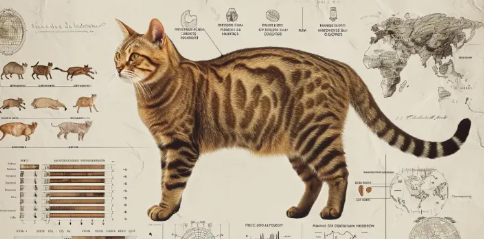The domestic cat, known scientifically as Felis catus, is one of the most beloved and widespread pets globally. These creatures have lived alongside humans for thousands of years, evolving from wild hunters into affectionate companions. The zoological name, Felis catus, not only classifies the domestic cat but also situates it within the broader taxonomic hierarchy of the animal kingdom. Understanding the scientific naming conventions and the biological significance of this nomenclature offers a deeper appreciation of our feline friends.
This article delves into the zoological naming of cats, exploring its origins, meanings, and implications. We will also examine the broader genus Felis and its relatives, discussing the characteristics that define this genus and how domestic cats fit into this taxonomic structure. With comprehensive research, clear and direct language, and engaging visuals, this article aims to provide a detailed understanding of the zoological aspects of cats.

The Origins of the Name Felis catus
The Taxonomic Hierarchy
Taxonomy is the science of classifying organisms into ordered systems based on their characteristics and evolutionary history. The classification of the domestic cat follows this system:
- Kingdom: Animalia (Animals)
- Phylum: Chordata (Animals with a spinal cord)
- Class: Mammalia (Mammals)
- Order: Carnivora (Carnivores)
- Family: Felidae (Cats)
- Genus: Felis (Small cats)
- Species: Felis catus (Domestic cat)
Etymology of Felis catus
The genus name Felis is derived from Latin, meaning “cat.” It encompasses a range of small cats, both domestic and wild. The species name catus is also Latin, meaning “domestic cat” or “house cat.” Together, Felis catus specifically refers to the domestic cat, differentiating it from wild relatives within the Felis genus.
The Genus Felis: A Closer Look
Overview of the Felis Genus
The genus Felis includes several species of small cats, all of which share certain anatomical and behavioral traits. These species are found in various regions across the globe and have adapted to a range of environments. Key members of the Felis genus include:
- Felis silvestris (Wildcat): Found in Europe, Africa, and Asia, the wildcat is considered the closest relative to the domestic cat.
- Felis nigripes (Black-footed Cat): Native to southern Africa, this is one of the smallest wild cat species.
- Felis chaus (Jungle Cat): Inhabiting the wetlands of South Asia, this species is known for its adaptability to various environments.
Each of these species exhibits unique adaptations that have allowed them to thrive in their respective habitats. Despite these differences, they all share the common characteristics of the Felis genus, such as retractable claws, sharp vision, and a carnivorous diet.
Evolutionary Significance of the Felis Genus
The evolutionary history of the Felis genus is closely tied to the development of modern cats. Fossil records suggest that the Felis genus emerged around 2 to 3 million years ago. These early cats were small, agile predators, well-suited to hunting small mammals and birds. Over time, the genus diversified, with different species adapting to various ecological niches.
The domestic cat, Felis catus, is believed to have descended from the African wildcat, Felis silvestris lybica. This domestication process likely began around 9,000 years ago in the Near East, where cats were drawn to human settlements by the abundance of rodents. Gradually, humans and cats formed a mutualistic relationship, leading to the development of the domestic cat as we know it today.
Characteristics of Felis catus
Physical Traits
Domestic cats are known for their graceful, flexible bodies, sharp retractable claws, and acute senses. These traits have evolved to make them highly effective hunters. Some of the key physical characteristics of Felis catus include:
- Size: Domestic cats typically weigh between 4 to 5 kilograms (9 to 11 pounds), although this can vary significantly depending on the breed and lifestyle.
- Coat: Cats have a wide variety of coat types, from short and sleek to long and fluffy, with colors ranging from solid black to intricate patterns like tabby and calico.
- Eyes: Cats possess large, round eyes that are highly sensitive to light, allowing them to see well in low-light conditions.
Behavioral Traits
Cats are known for their independence and strong predatory instincts. Even domestic cats retain many behaviors of their wild ancestors, such as:
- Hunting: Despite being well-fed, many domestic cats continue to hunt small animals like birds and rodents.
- Territoriality: Cats are territorial animals, often marking their home ranges with scent markings and vocalizations.
- Social Structure: While often seen as solitary, domestic cats can form complex social hierarchies, particularly in environments with abundant resources.
The Role of Felis catus in Human Society
Historical Relationship Between Cats and Humans
Cats have played a significant role in human societies for thousands of years. In ancient Egypt, cats were revered and even worshipped as symbols of grace and protection. The goddess Bastet, often depicted as a lioness or a woman with the head of a lioness, was associated with home, fertility, and childbirth, reflecting the deep connection between cats and domestic life.
In Europe, cats were valued for their hunting skills, particularly in controlling rodent populations. However, during the Middle Ages, cats were often associated with witchcraft and superstition, leading to widespread persecution. It wasn’t until the 17th century that cats regained their status as valued companions in many households.
Cats in Modern Times
Today, domestic cats are one of the most popular pets in the world. Their independent yet affectionate nature makes them well-suited to modern living environments, from rural homes to urban apartments. The popularity of cats has also led to the development of numerous breeds, each with its own unique characteristics and appeal.
The cultural significance of cats continues to grow, with cats playing prominent roles in literature, art, and even internet culture. From T.S. Eliot’s “Old Possum’s Book of Practical Cats” to viral internet sensations like Grumpy Cat, cats have captured the human imagination in ways that few other animals have.
Comparative Characteristics of Felis catus and Related Species
| Characteristic | Felis catus (Domestic Cat) | Felis silvestris (Wildcat) | Felis nigripes (Black-footed Cat) | Felis chaus (Jungle Cat) |
|---|---|---|---|---|
| Size | 4-5 kg | 3-6 kg | 1-2 kg | 4-16 kg |
| Coat Type | Varies widely | Brownish-gray with stripes | Tawny with black spots | Tawny or grayish-brown |
| Habitat | Domestic, urban and rural | Forests, savannas, deserts | Grasslands, savannas | Wetlands, marshes |
| Social Structure | Solitary or small groups | Solitary | Solitary | Solitary |
| Hunting Behavior | Opportunistic | Ambush predator | Highly efficient nocturnal hunter | Ambush predator |
Conclusion
The zoological name of the domestic cat, Felis catus, is more than just a label; it represents a rich history of evolution, adaptation, and coexistence with humans. By understanding the scientific naming conventions and the biological significance of this nomenclature, we gain a deeper appreciation for these remarkable animals.
FAQs
1. What does the name Felis catus mean?
- The name Felis catus is derived from Latin, where “Felis” means “cat,” and “catus” refers to a “domestic cat.”
2. How is Felis catus different from other species in the Felis genus?
- Felis catus is specifically the domestic cat, while other species in the Felis genus include wildcats like Felis silvestris and Felis nigripes.
3. Why were cats domesticated?
- Cats were likely domesticated around 9,000 years ago due to their ability to control rodent populations, which benefited early human agricultural societies.
4. How did the domestic cat evolve?
- The domestic cat evolved from the African wildcat (Felis silvestris lybica), with which it shares many physical and behavioral traits.
5. What role do cats play in human culture today?
- Cats are popular pets worldwide and have a significant cultural presence, from literature and art to internet memes.






